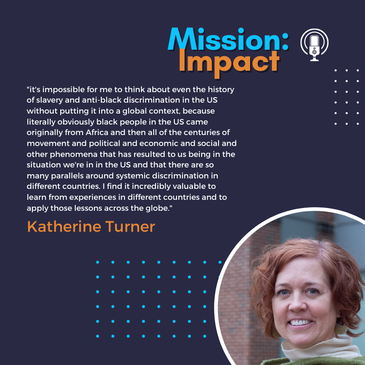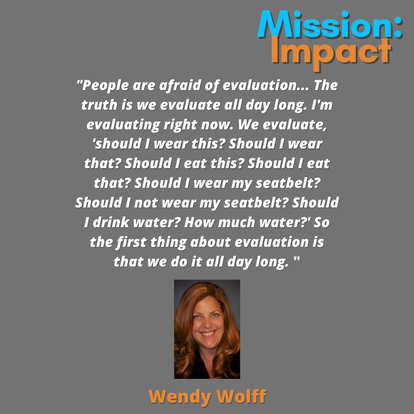Mission: Impact podcast & blog
Build a better world without becoming a martyr to your nonprofit cause
Listen on:
 In episode 66 of Mission: Impact, Carol and her guest, Katherine Turner discuss:
Katherine L. Turner, MPH (she/elle) is the founding President of Global Citizen, LLC consulting firm that strengthens inclusive leadership and effects organizational transformation and social impact by advancing diversity, equity, and inclusion, public health, human rights, and global competence. As Adjunct Professor at UNC-Chapel Hill, she teaches and mentors global leaders on leadership, global competence, and other topics. Katherine provides strategic leadership on global advisory committees, has founded and led boards of directors of nonprofit organizations, and won awards for excellence in leadership, teaching, public health, and advocacy. She is an internationally-recognized executive consultant, coach, thought leader, speaker, author, and change agent who has worked in English, French, and Dutch across all sectors in over 50 countries to deliver high-impact results for a better world. Important Links and Resources:
 In episode 17 of Mission: Impact, some of the topics that Carol and her guest, Wendy Wolff discussed include: - How leading a non-profit differs from leading a for-profit business - Awareness vs. action - Why people are scared of evaluation - Assumptions to avoid when working with communities - Changing social norms - Where to start evaluation on an organizational level - The barriers to evidence-based testing Guest Information: Activating and coordinating community responses to the HIV/AIDS epidemic was how Wendy Wolff began her career in the nonprofit sector. Her early career helped her to build a strong understanding about the value and role of the community in program planning and policy development. She brings nearly 25 years of diverse consulting experiences to her role as Director of Strategic Engagement for Maryland Nonprofits. Wendy has collaborated with government agencies; universities; non-profit organizations; and faith-based organizations to enhance the quality of life within many communities throughout the United States. She uses her strategic thinking skills to help clients synthesize information from wide-ranging sources, reframe problems while uncovering root causes to find refreshing, creative and effective solutions. Over the past two decades, Wendy has helped thousands of organizations and their people to create brighter futures for the communities in which they serve. Her excitement in working with the members of Maryland Nonprofit’s is infectious. She values the genius that each and every person brings to their role in the sector and works diligently to elevate any person that she engages with. Ms. Wolff holds a Master’s Degree in Public Health from New York University. She has resided as an Adjunct Professor at the University of Denver and as an Associate Faculty Member at Indian River State College. Wendy is a licensed consultant with the Standards for Excellence® Institute. Ms. Wolff’s first book, The Letter Writing Project (Blooming Twig Books), was published in August 2014. Evaluation Resources
Click "Read More" for Transcript: |
Archives
April 2024

Grace Social Sector Consulting, LLC, owns the copyright in and to all content in and transcripts of the Mission: Impact podcast, as well as the Mission: Impact blog with all rights reserved, including right of publicity.
|
Telephone301-857-9335
|
info[at]gracesocialsector.com
|
Grace Social Sector Consulting, LLC, owns the copyright in and to all content in, including transcripts and audio of the Mission: Impact podcast and all content on this website, with all rights reserved, including right of publicity.
|